ABSTRACT
This paper aims to briefly overview the Agricultural Census 2023 (2023) compared to the previous Agricultural Census 2013 (ST 2013). It found that the number of farmers has increased by about 3,206,733 households i.e., from 26,135,469 households in 2013 to 29,342,202 households in 2023, or an increase of about 12.27%. But there is a tendency for the agricultural sector to be carried out by old (aging) farmers. Apart from that, the proportion of small farmers increased from 50.33% in 2013 to 60.84% in 2023. These phenomena must be addressed immediately through collaborating support from relevant institutions/organizations to develop Indonesia’s agricultural development. It comprises farmer’s regeneration, agricultural investment, agricultural precision, and policy support including high-value commodities of the country.
Keywords: review, agricultural census, 2023, Indonesia
INTRODUCTION
Statistics are important for planning, implementing, monitoring, and evaluating the implementation of various activities in all aspects of national development. It is carried out through data collection by: (1) Census; (2) Survey; (3) Compilation of administrative products; and (4) Other methods by developments in science and technology (GoI, 2017).
In December 2023, the Indonesia Central Statistics Agency (BPS, 2023) has just released the Agricultural Census 2023 Phase 1. It will be followed by the Agricultural Economic Survey Phase 2 and the Agricultural Production and Environmental Survey in 2024 Phase 3. It is mandated by Law Number No.16/1997 concerning Statistics (GoI, 1997) and designed by referring to the World Programme for the Census of Agriculture 2020 (UN-FAO, 2020). This paper briefly overviews the result of the Agricultural Census 2023 Phase 1 and analyzes the performance of the agricultural sector of the country in the last decade (2013-2023) by comparing it to the result of the Agricultural Census 2013 (ST 2013). The paper also compares the results from several studies.
FRAMEWORK
The Agricultural Census 2023 (ST 2023) is the seventh agricultural census in Indonesia since it was first implemented in 1963 (ST 1963) and continues every 10 years. It comprises a complete enumeration data set on the agricultural sector comprising three holdings i.e., individual agricultural holdings, agricultural corporation holdings, and other agricultural holdings. These holdings engage in agricultural sub-sectors (food crops, horticulture, estate crops, livestock, fishery, forestry, and agricultural services). The framework of this census can be seen in Figure 1 covering data and information on agricultural households and agricultural holdings classification, demographic of agricultural holders, agricultural land and fertilizer use, gurem farmer, millennial farmer, urban farming, and agricultural commodities
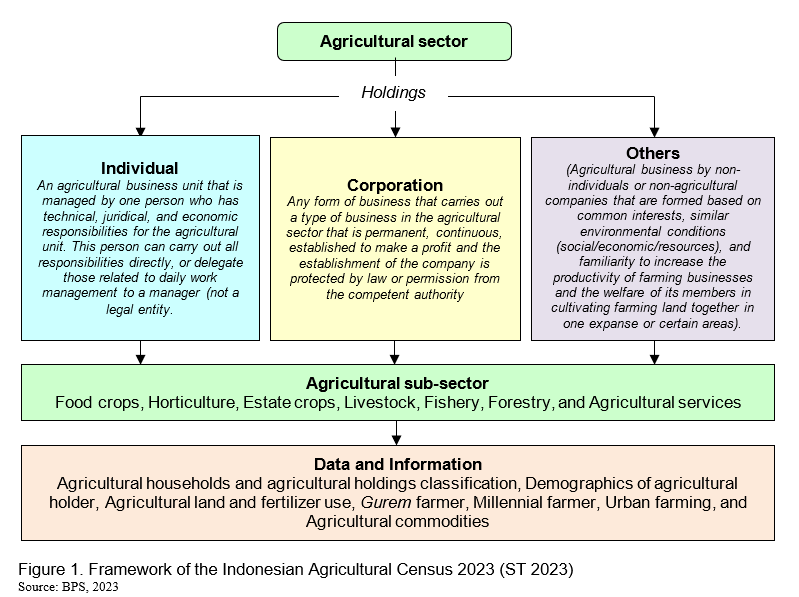
BRIEF OVERVIEW
Agricultural households and agricultural holdings classification
In 2023, there are 29,360,833 units of agricultural holdings in Indonesia. This number has decreased by about 7.42% from 2013 (31,715,486 units). In the same period, there were 29,342,202 units of individual agricultural holdings in the country, followed by 5,705 units of agricultural corporations and 12,926 units of other agricultural holdings (Table 1). As compared to 2013, the number of individual agricultural holdings has decreased by about 7.45%. Conversely, the numbers of agricultural corporations and other agricultural holdings have respectively increased by about 35.54% and 116.08%. This indicates that the role of non-individual agricultural holdings has been quite considerable in supporting the development of agriculture in Indonesia in the last decade (2013-2023).

The structure of agricultural holding by sub-sector is presented in Table 2. The table indicate that during 2013-2023 period, the number of estate crops holding has declined much larger (14.81%) followed by food crops (12.27%), horticulture (10.41%), and livestock (7.11%). This evidence is in accordance with the story of rural transformation indicating an increased share of high-value commodities (horticulture, estate crops, and livestock) over time (Sudaryanto et.al, 2023). To some extent, the evidence is also supported by the most recent research by Jamal et al (2024).
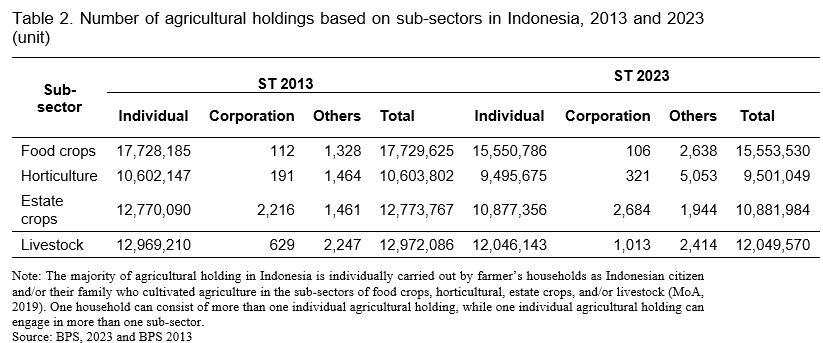
Demographics of the agricultural holder
Farmer’s age
The majority (>60%) of farmers in Indonesia are under the age groups of 45 years old up to above 65 years old (Table 3). This indicates that the agricultural sector in the country is carried out by old (aging) farmers. The number of individual agricultural holdings has increased by about 12.27% i.e., from 26,135,469 households in ST 2013 to 29,342,202 households in ST 2023. The highest increase was in the age groups of 55 years old up to above 65 years old. Meanwhile, the number of farmers of the age group 25-34 years old and 35-44 years old respectively decreased by about 3.98% and 5.91%. The number of farmers who can be classified as relatively young farmers (15-24 years old) had quite increased by about 58.01% during the same period. The regeneration of farmers must be paid attention to by the country. There is an opportunity since the proportion of the age group of 15-24 years old is quite significant to support the existence of young farmers, especially millennial farmers in Indonesia.
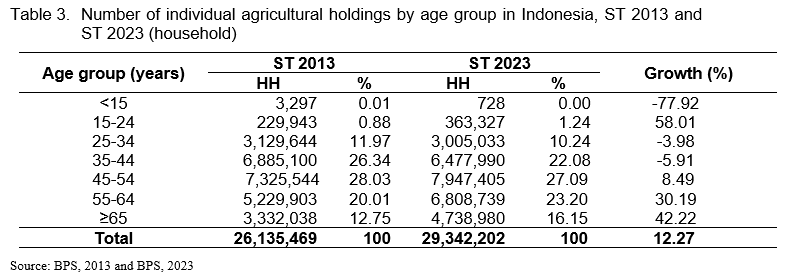
Millennial farmers
Millennial farmers are farmers aged between 19 and 39 years old, and/or farmers who are adaptive to digital technology (MoA, 2019). Millennial farmers are about 25.61% of the total generation of farmers in Indonesia. Other generations include Pre-boomers born before 1945 (2.24%), Baby boomers born 1946-1964 (27.61%), Generation X born 1965-1980 (42.39%), and Generation Z born 1997-2012 (25.61%). The highest distribution of millennial farmers was in East Java province. Meanwhile, the lowest numbers were in Maluku and Papua regions, some provinces in Sumatra, Java, Kalimantan, and Sulawesi regions (Table 4)
Based on gender, millennial farmers are still dominated by males (89.03%) as compared to females (10.97%). The proportion of millennial male farmers both using and not using technology is higher than female millennial farmers i.e., 37.99% and 27.52% (Table 5).
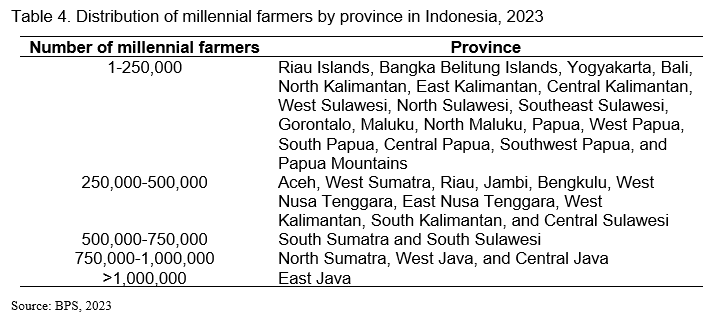
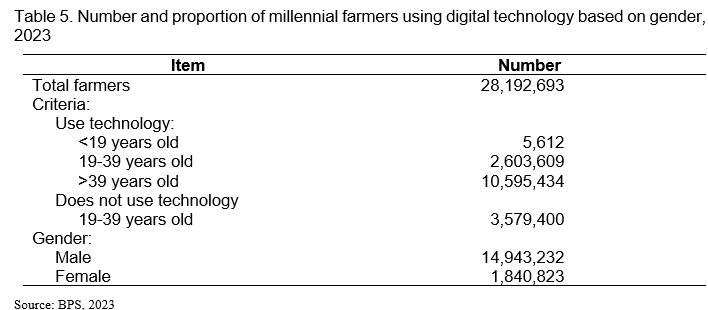
Agricultural land
In ST 2023, there are 27,763,821 agricultural land users in Indonesia. These numbers increased by about 7.82% as compared to agricultural land users in ST 2013. The highest users are in food crops, followed by livestock, estate crops, and horticulture sub-sectors (Figure 2).
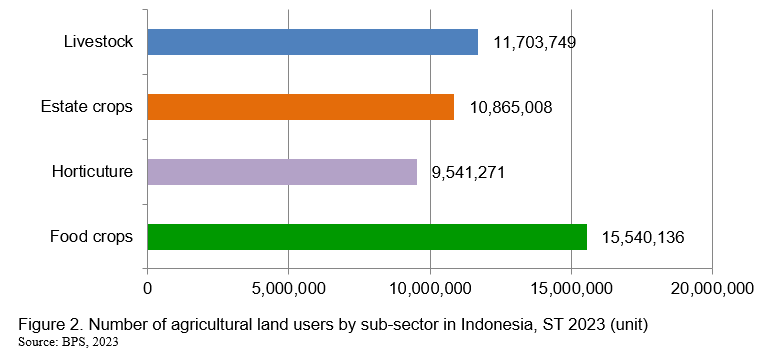
The number of agricultural land users by group of agricultural land area utilized can be seen in Table 6. It shows that the highest users are the group of agricultural land area utilized below 0.50 hectares (small farmers). It notes that from ST 2013 to ST 2023, the group of agricultural land users below 0.10 hectares increased significantly by about 70.31%.

Small farmers
Smal farmers are individuals and/or their families who carry out agricultural business with control of agricultural land (farm and residential) of less than 0.5 hectares (BPS, 2023). This is part of agricultural land users as can be seen in Table 7. It shows that the number of gurem farmers increased by about 18.54% from ST 2013 to ST 2023.

The proportion of small farmers in ST 2013 and ST 2023 can be seen in Figure 3. It shows that the proportion of small farmers in ST 2023 was larger than that in ST 2013 (60.84% vs, 39.16% and 55.33% vs. 44.67%).
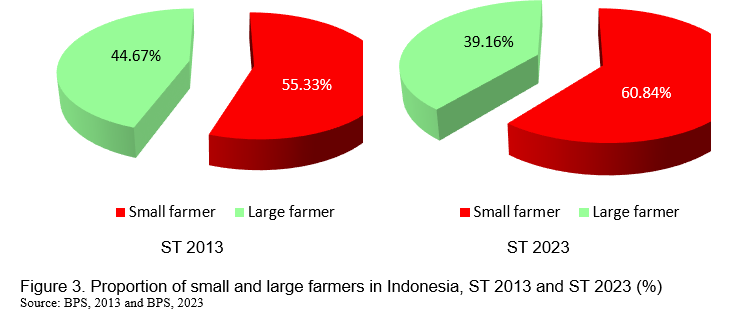
The distribution of small farmers by region in Indonesia is presented in Table 8. It encompasses in Sumatra, Java, Bali-Nusra, Kalimantan, Sulawesi, and Maluku-Papua regions. Typologically, a small farmer is local specific Indonesia. It has a consequence to the choice of development approach in agricultural sector in the country. One of solutions to this circumstance is to promote a corporate farming approach, in which some farmers in a region is managed collectively to attain an economic of scale and efficiently. But in practice this initiative has not shown a notable progress. Therefore, small farmers will gradually decline as some of them leave the farm and work in the non-farm sectors.
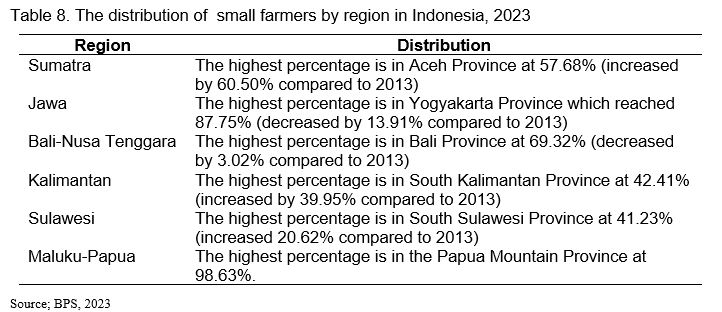
Urban farming
Agricultural land in urban areas is getting narrower along with the increase in urban population, while the need for consumption of agricultural products is quite high. Urban areas are dependent on agricultural products from other areas, so urban farming is one solution to reduce this dependence while also helping control inflation, developing the local economy, reducing transportation costs, increasing public/community participation, and improving the quality of the urban environment. Some activities that are classified as urban farming include cultivating vegetables in city parks, building roofs, or in closed spaces such as greenhouses, and livestock businesses. To promote urban farming the Ministry of Agriculture provides technical guidance on improving farm practices and providing better quality seeds, such as vegetables.
Even though it is only carried out in a few urban areas, there are quite a lot of urban farming activities in Indonesia, namely 12,919 units of household agriculture and 13,019 units of individual agriculture. Urban farming activities are spread across regions (Figure 4). The largest number was in Java and Sumatra regions.
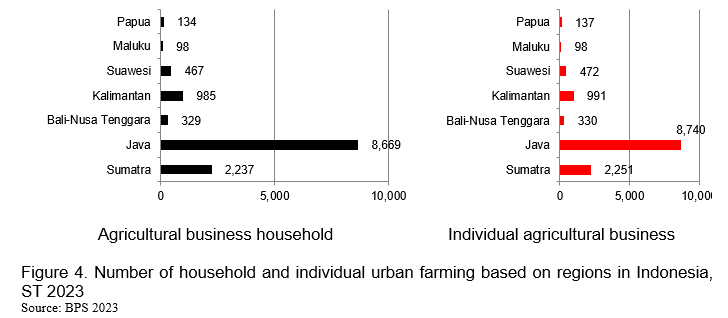
Agricultural commodities
The type of agricultural commodity that is most cultivated by individual agricultural holdings in Indonesia is non-hybrid rice (32.08%). Other commodities such as beef, goat, oil palm, cassava, rubber, and hybrid rice were cultivated by less than 10% of farmers (Table 9. The agricultural commodities that are most cultivated in the Java region are food crops, especially hybrid lowland rice, while in Sumatra and Kalimantan regions are estate crops (oil palm and rubber).
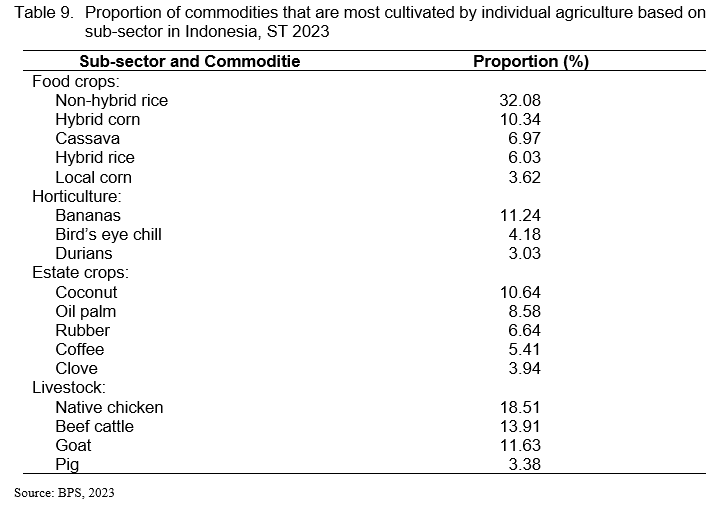
CONCLUSION AND RECOMMENDATIONS
The results of the Indonesian Agricultural Census 2023 (ST 2023) highlight two key trends when compared to previous censuses, particularly the Indonesian Agricultural Census 2013 (ST 2013). First, more than 60% of farmers in Indonesia fall within the age groups of 45 years old up to above 65 years (aging farmers) indicating an aging farmer population. This figure has risen by approximately 12.27% i.e., from 26,135,469 households in ST 2013 to 29,342,202 households in ST 2023. Second, the number of agricultural land users has increased by about 7.82% from ST 2013 to 2023, with the highest concentration of users in the food crop sector, followed by livestock, estate crops, and horticulture sub-sectors. Additionally, the number of small farmers increased by about 18.54% from ST 2013 to ST 2023. In response to these challenges, two strategic programs are recommended. First, the regeneration of the farming population by encouraging the transition from older to younger farmers, and second, the promotion of corporate farming which has seen significant growth over the past decade in Indonesia.
REFERENCES
BPS. 2013. Laporan Hasil Pencacahan Lengkap Sensus Pertanian 2013 (Complete Enumeration Results Report for the Agricultural Census 2013). Badan Pusat Statistik (Indonesian Central Bureau of Statistics). Jakarta.
BPS. 2023. Hasil Pencacahan Lengkap Sensus Pertanian 2023 Tahap I (Complete Enumeration Results of the Agricultural Census 2023 Phase I). Badan Pusat Statistik (Indonesian Central Statistics Agency). Jakarta.
GoI. 1997. Undang-undang Republik Indonesia Nomor 16 Tahun 1997 tentang Statistik (Law Number 16/1997 concerning Statistics). Government of Indonesia. Jakarta.
Jamal, E, Sahara, Komalawati, I.Martino, P.Buhaerah, S.Izzulhaq, S.Amaliah, F.S.Ahmad, W. Metafurry, D.J.Mutaqin, I. T.Firdaus, D.Setyawati, V.Yulaswati, I.S. Beik, I. W.Wardhana, J. Indarto, A.E.Nugroho, B.Arifin, T.Sudaryanto. 2024. Foresight and Metric to Accelerate Food, Land , and Water System Transformation: Indonesia Case. Reseach report submitted to the International Food Policy Research Institute. IPB University, Ministry of Natonal Development Planning (Bappenas), National Research and Innovation Agency. Jakart
MoA. 2019. Peraturan Menteri Pertanian Republik Indonesia Nomor 4 Tahun 2019 tentang Pedoman Gerakan Pembangunan Sumber Daya Manusia Pertanian menuju Lumbung Pangan Dunia 2045 (·MoA. 2019. Regulation of the Indonesian Minister of Agriculture Number 4/2019 concerning Guidelines for the Agricultural Human Resources Development Movement towards the World Food Storage 2045. Indonesian Ministry of Agriculture. Jakarta.
Sudaryanto, T, Erwidodo, S.K.Dermoredjo, H.J.Purba, R.R.Rachmawati, A.R.Irawan. 2023. Regional rural transformation and its association with household income and poverty incidence in Indonesia in the last two decades. Journal of Integrative Agriculture 2023, 22(12): 2–14.
UN-FAO. 2020. World Programme for the Census of Agriculture 2020. Food and Agriculture of the United Nations. Rome.
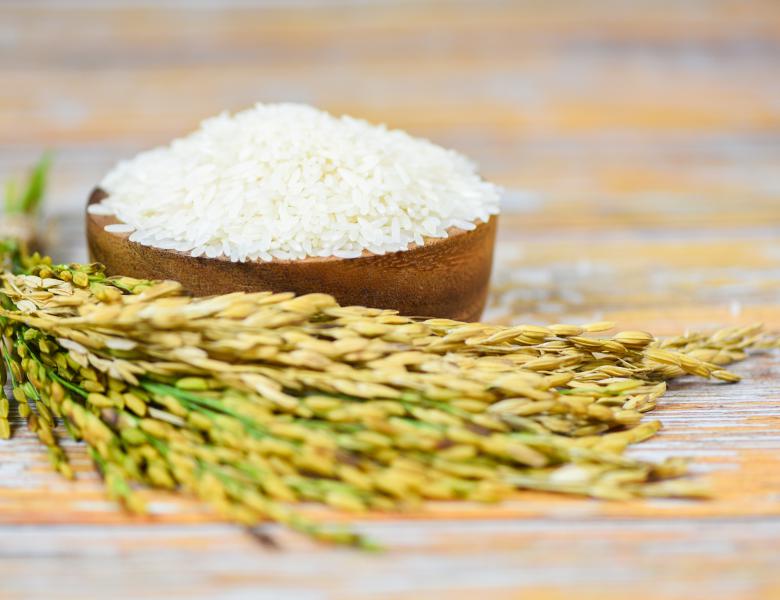
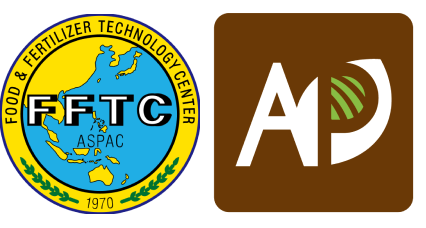

Brief Overview of the Indonesian Agricultural Census 2023
ABSTRACT
This paper aims to briefly overview the Agricultural Census 2023 (2023) compared to the previous Agricultural Census 2013 (ST 2013). It found that the number of farmers has increased by about 3,206,733 households i.e., from 26,135,469 households in 2013 to 29,342,202 households in 2023, or an increase of about 12.27%. But there is a tendency for the agricultural sector to be carried out by old (aging) farmers. Apart from that, the proportion of small farmers increased from 50.33% in 2013 to 60.84% in 2023. These phenomena must be addressed immediately through collaborating support from relevant institutions/organizations to develop Indonesia’s agricultural development. It comprises farmer’s regeneration, agricultural investment, agricultural precision, and policy support including high-value commodities of the country.
Keywords: review, agricultural census, 2023, Indonesia
INTRODUCTION
Statistics are important for planning, implementing, monitoring, and evaluating the implementation of various activities in all aspects of national development. It is carried out through data collection by: (1) Census; (2) Survey; (3) Compilation of administrative products; and (4) Other methods by developments in science and technology (GoI, 2017).
In December 2023, the Indonesia Central Statistics Agency (BPS, 2023) has just released the Agricultural Census 2023 Phase 1. It will be followed by the Agricultural Economic Survey Phase 2 and the Agricultural Production and Environmental Survey in 2024 Phase 3. It is mandated by Law Number No.16/1997 concerning Statistics (GoI, 1997) and designed by referring to the World Programme for the Census of Agriculture 2020 (UN-FAO, 2020). This paper briefly overviews the result of the Agricultural Census 2023 Phase 1 and analyzes the performance of the agricultural sector of the country in the last decade (2013-2023) by comparing it to the result of the Agricultural Census 2013 (ST 2013). The paper also compares the results from several studies.
FRAMEWORK
The Agricultural Census 2023 (ST 2023) is the seventh agricultural census in Indonesia since it was first implemented in 1963 (ST 1963) and continues every 10 years. It comprises a complete enumeration data set on the agricultural sector comprising three holdings i.e., individual agricultural holdings, agricultural corporation holdings, and other agricultural holdings. These holdings engage in agricultural sub-sectors (food crops, horticulture, estate crops, livestock, fishery, forestry, and agricultural services). The framework of this census can be seen in Figure 1 covering data and information on agricultural households and agricultural holdings classification, demographic of agricultural holders, agricultural land and fertilizer use, gurem farmer, millennial farmer, urban farming, and agricultural commodities
BRIEF OVERVIEW
Agricultural households and agricultural holdings classification
In 2023, there are 29,360,833 units of agricultural holdings in Indonesia. This number has decreased by about 7.42% from 2013 (31,715,486 units). In the same period, there were 29,342,202 units of individual agricultural holdings in the country, followed by 5,705 units of agricultural corporations and 12,926 units of other agricultural holdings (Table 1). As compared to 2013, the number of individual agricultural holdings has decreased by about 7.45%. Conversely, the numbers of agricultural corporations and other agricultural holdings have respectively increased by about 35.54% and 116.08%. This indicates that the role of non-individual agricultural holdings has been quite considerable in supporting the development of agriculture in Indonesia in the last decade (2013-2023).
The structure of agricultural holding by sub-sector is presented in Table 2. The table indicate that during 2013-2023 period, the number of estate crops holding has declined much larger (14.81%) followed by food crops (12.27%), horticulture (10.41%), and livestock (7.11%). This evidence is in accordance with the story of rural transformation indicating an increased share of high-value commodities (horticulture, estate crops, and livestock) over time (Sudaryanto et.al, 2023). To some extent, the evidence is also supported by the most recent research by Jamal et al (2024).
Demographics of the agricultural holder
Farmer’s age
The majority (>60%) of farmers in Indonesia are under the age groups of 45 years old up to above 65 years old (Table 3). This indicates that the agricultural sector in the country is carried out by old (aging) farmers. The number of individual agricultural holdings has increased by about 12.27% i.e., from 26,135,469 households in ST 2013 to 29,342,202 households in ST 2023. The highest increase was in the age groups of 55 years old up to above 65 years old. Meanwhile, the number of farmers of the age group 25-34 years old and 35-44 years old respectively decreased by about 3.98% and 5.91%. The number of farmers who can be classified as relatively young farmers (15-24 years old) had quite increased by about 58.01% during the same period. The regeneration of farmers must be paid attention to by the country. There is an opportunity since the proportion of the age group of 15-24 years old is quite significant to support the existence of young farmers, especially millennial farmers in Indonesia.
Millennial farmers
Millennial farmers are farmers aged between 19 and 39 years old, and/or farmers who are adaptive to digital technology (MoA, 2019). Millennial farmers are about 25.61% of the total generation of farmers in Indonesia. Other generations include Pre-boomers born before 1945 (2.24%), Baby boomers born 1946-1964 (27.61%), Generation X born 1965-1980 (42.39%), and Generation Z born 1997-2012 (25.61%). The highest distribution of millennial farmers was in East Java province. Meanwhile, the lowest numbers were in Maluku and Papua regions, some provinces in Sumatra, Java, Kalimantan, and Sulawesi regions (Table 4)
Based on gender, millennial farmers are still dominated by males (89.03%) as compared to females (10.97%). The proportion of millennial male farmers both using and not using technology is higher than female millennial farmers i.e., 37.99% and 27.52% (Table 5).
Agricultural land
In ST 2023, there are 27,763,821 agricultural land users in Indonesia. These numbers increased by about 7.82% as compared to agricultural land users in ST 2013. The highest users are in food crops, followed by livestock, estate crops, and horticulture sub-sectors (Figure 2).
The number of agricultural land users by group of agricultural land area utilized can be seen in Table 6. It shows that the highest users are the group of agricultural land area utilized below 0.50 hectares (small farmers). It notes that from ST 2013 to ST 2023, the group of agricultural land users below 0.10 hectares increased significantly by about 70.31%.
Small farmers
Smal farmers are individuals and/or their families who carry out agricultural business with control of agricultural land (farm and residential) of less than 0.5 hectares (BPS, 2023). This is part of agricultural land users as can be seen in Table 7. It shows that the number of gurem farmers increased by about 18.54% from ST 2013 to ST 2023.

The proportion of small farmers in ST 2013 and ST 2023 can be seen in Figure 3. It shows that the proportion of small farmers in ST 2023 was larger than that in ST 2013 (60.84% vs, 39.16% and 55.33% vs. 44.67%).
The distribution of small farmers by region in Indonesia is presented in Table 8. It encompasses in Sumatra, Java, Bali-Nusra, Kalimantan, Sulawesi, and Maluku-Papua regions. Typologically, a small farmer is local specific Indonesia. It has a consequence to the choice of development approach in agricultural sector in the country. One of solutions to this circumstance is to promote a corporate farming approach, in which some farmers in a region is managed collectively to attain an economic of scale and efficiently. But in practice this initiative has not shown a notable progress. Therefore, small farmers will gradually decline as some of them leave the farm and work in the non-farm sectors.
Urban farming
Agricultural land in urban areas is getting narrower along with the increase in urban population, while the need for consumption of agricultural products is quite high. Urban areas are dependent on agricultural products from other areas, so urban farming is one solution to reduce this dependence while also helping control inflation, developing the local economy, reducing transportation costs, increasing public/community participation, and improving the quality of the urban environment. Some activities that are classified as urban farming include cultivating vegetables in city parks, building roofs, or in closed spaces such as greenhouses, and livestock businesses. To promote urban farming the Ministry of Agriculture provides technical guidance on improving farm practices and providing better quality seeds, such as vegetables.
Even though it is only carried out in a few urban areas, there are quite a lot of urban farming activities in Indonesia, namely 12,919 units of household agriculture and 13,019 units of individual agriculture. Urban farming activities are spread across regions (Figure 4). The largest number was in Java and Sumatra regions.
Agricultural commodities
The type of agricultural commodity that is most cultivated by individual agricultural holdings in Indonesia is non-hybrid rice (32.08%). Other commodities such as beef, goat, oil palm, cassava, rubber, and hybrid rice were cultivated by less than 10% of farmers (Table 9. The agricultural commodities that are most cultivated in the Java region are food crops, especially hybrid lowland rice, while in Sumatra and Kalimantan regions are estate crops (oil palm and rubber).
CONCLUSION AND RECOMMENDATIONS
The results of the Indonesian Agricultural Census 2023 (ST 2023) highlight two key trends when compared to previous censuses, particularly the Indonesian Agricultural Census 2013 (ST 2013). First, more than 60% of farmers in Indonesia fall within the age groups of 45 years old up to above 65 years (aging farmers) indicating an aging farmer population. This figure has risen by approximately 12.27% i.e., from 26,135,469 households in ST 2013 to 29,342,202 households in ST 2023. Second, the number of agricultural land users has increased by about 7.82% from ST 2013 to 2023, with the highest concentration of users in the food crop sector, followed by livestock, estate crops, and horticulture sub-sectors. Additionally, the number of small farmers increased by about 18.54% from ST 2013 to ST 2023. In response to these challenges, two strategic programs are recommended. First, the regeneration of the farming population by encouraging the transition from older to younger farmers, and second, the promotion of corporate farming which has seen significant growth over the past decade in Indonesia.
REFERENCES
BPS. 2013. Laporan Hasil Pencacahan Lengkap Sensus Pertanian 2013 (Complete Enumeration Results Report for the Agricultural Census 2013). Badan Pusat Statistik (Indonesian Central Bureau of Statistics). Jakarta.
BPS. 2023. Hasil Pencacahan Lengkap Sensus Pertanian 2023 Tahap I (Complete Enumeration Results of the Agricultural Census 2023 Phase I). Badan Pusat Statistik (Indonesian Central Statistics Agency). Jakarta.
GoI. 1997. Undang-undang Republik Indonesia Nomor 16 Tahun 1997 tentang Statistik (Law Number 16/1997 concerning Statistics). Government of Indonesia. Jakarta.
Jamal, E, Sahara, Komalawati, I.Martino, P.Buhaerah, S.Izzulhaq, S.Amaliah, F.S.Ahmad, W. Metafurry, D.J.Mutaqin, I. T.Firdaus, D.Setyawati, V.Yulaswati, I.S. Beik, I. W.Wardhana, J. Indarto, A.E.Nugroho, B.Arifin, T.Sudaryanto. 2024. Foresight and Metric to Accelerate Food, Land , and Water System Transformation: Indonesia Case. Reseach report submitted to the International Food Policy Research Institute. IPB University, Ministry of Natonal Development Planning (Bappenas), National Research and Innovation Agency. Jakart
MoA. 2019. Peraturan Menteri Pertanian Republik Indonesia Nomor 4 Tahun 2019 tentang Pedoman Gerakan Pembangunan Sumber Daya Manusia Pertanian menuju Lumbung Pangan Dunia 2045 (·MoA. 2019. Regulation of the Indonesian Minister of Agriculture Number 4/2019 concerning Guidelines for the Agricultural Human Resources Development Movement towards the World Food Storage 2045. Indonesian Ministry of Agriculture. Jakarta.
Sudaryanto, T, Erwidodo, S.K.Dermoredjo, H.J.Purba, R.R.Rachmawati, A.R.Irawan. 2023. Regional rural transformation and its association with household income and poverty incidence in Indonesia in the last two decades. Journal of Integrative Agriculture 2023, 22(12): 2–14.
UN-FAO. 2020. World Programme for the Census of Agriculture 2020. Food and Agriculture of the United Nations. Rome.